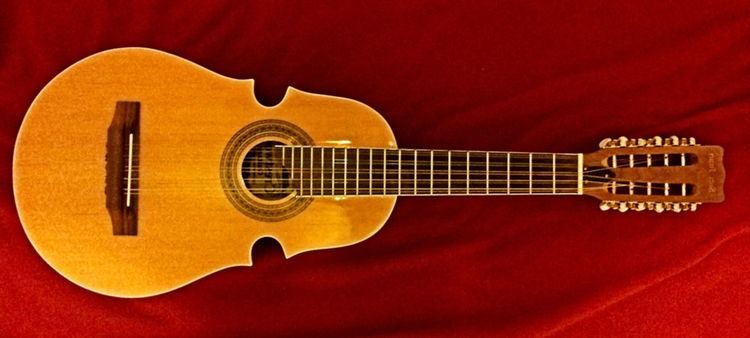 | ||
Hornbostel–Sachs classification (Composite chordophone) | ||
The Puerto Rican cuatro is the national instrument of Puerto Rico. It belongs to the lute family of string instruments, and is guitar-like in function, but with a shape closer to that of the violin. The word cuatro means "four", which was the total of strings of the very first Puerto Rican cuatro.
Contents
- History
- Types of Puerto Rican cuatros
- Cuatro shapes sizes and variants
- Cuatro orchestras of Puerto Rico
- The Puerto Rican Cuatro Project
- Use in popular music
- References
The current cuatro has ten strings in five courses, tuned, in fourths, from low to high B3 B2♦E4 E3♦A3 A3♦D4 D4♦G4 G4 (note that the bottom two pairs are in octaves, while the top three pairs are tuned in unison), and a scale length of 500-520 millimetres.
The cuatro is the most familiar of the three instruments which make up the Puerto Rican jíbaro orchestra (the cuatro, the tiple and the bordonúa).
A cuatro player is called a cuatrista. This instrument has had its prominent performers like Edwin Colón Zayas, Yomo Toro and the maestro Maso Rivera.
Note that cuatro is a name also applied to a number of other somewhat differently-configured instruments, including the Venezuelan Cuatro, the Cuban cuatro and some small Spanish instruments.
History
Very little is known about the exact origin of the cuatro. However, most experts believe that the cuatro has existed on the island in one form or another for about 400 years. The Spanish instrument that it is most closely related to is the vihuela poblana (also known as the Medieval/Renaissance guitar), which had four courses, two strings each for eight strings in total as well as the Spanish Medieval/Renaissance four course and the Spanish laúd, particularly in the Canary Islands.
There was a "cuatro antiguo" which had four single strings, then eight strings in four doubled courses, and then the modern cuatro with five double courses. Despite the name, however, the origins are not clear.
Types of Puerto Rican cuatros
There are three main types of cuatro: cuatro antiguo of four orders and four strings, the "Southern" cuatro of four orders and eight strings, and the cuatro "moderno" of five orders and ten strings.
Cuatro shapes, sizes and variants.
Sound Box designs:
Variants
In the 1950s, there was an effort to produce a "classical" ensemble of cuatros, with various-sized instruments taking on the role of the violins, violas, cellos, and double bases in a classical orchestra. To meet these roles cuatros of the aviolinado style were produced in four different sizes and tunings: Cuatro Soprano, Cuatro Alto, Cuatro Tradicional (the standard instrument, also called Cuatro Tenor), and Cuatro Bajo (Bass Cuatro): all have ten strings and are tuned in fourths. The project met with only limited success and today most of these variants are rare, with the cuatro tradicional surviving as the standard instrument.
There is also a Cuatro Lírico ("lyrical cuatro"), which is about the size of the Tenor, but has a deep jelly-bean shaped body; a Cuatro Sonero, which has fifteen strings in five courses of three strings each; and a Seis, which is a Cuatro Tradicional with an added two string course (usually a lower course), giving it a total of twelve strings in six courses.
Cuatro orchestras of Puerto Rico
The original cuatro orchestra was the orquesta jíbara which consisted of a various number of different string instruments:
At least two configurations of "classical" cuatro orchestra were formed in the 1950s and 1960s:
Or:
As noted, most of the instrumental variants are now rare, as are these classical groupings. There have been, however, modern efforts to revive the orquesta jíbara.
"The Puerto Rican Cuatro Project"
William Cumpiano and Christina Sotomayor founded the Puerto Rican Cuatro Project, a non-profit organization dedicated to fostering the traditions that surround the national instrument of Puerto Rico, by means of gathering, promoting and preserving the cultural memories of Puerto Rican musical traditions, folkloric stringed instruments and musicians. The Cuatro Project is also dedicated to promoting and preserving the Puerto Rican décima verse form and the traditional song as created by its greatest troubadours, living and past.
Cumpiano, together with Sotomayor and Wilfredo Echevarría, wrote, directed and produced twoDVD documentaries for The Cuatro Project. They are:OUR CUATRO Vol.1, the first feature-length documentary about the cuatro and its music and OUR CUATRO Vol. 2: A Historic Concert. Cumpiano and cultural researcher David Morales produced another DVD documentary THE DÉCIMA BORINQUEÑA: An ancient poetic singing tradition, directed by Myriam Fuentes. The proceeds of these recordings were to be used for the research and documentation activities of the Puerto Rican Cuatro Project.
Use in popular music
Jon Anderson used a cuatro on the Yes album Tormato, although the sleeve-notes misdescribe the instrument as an Álvarez ten string guitar.
